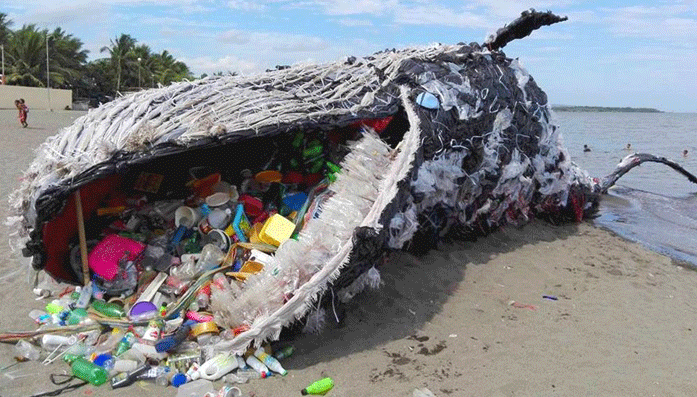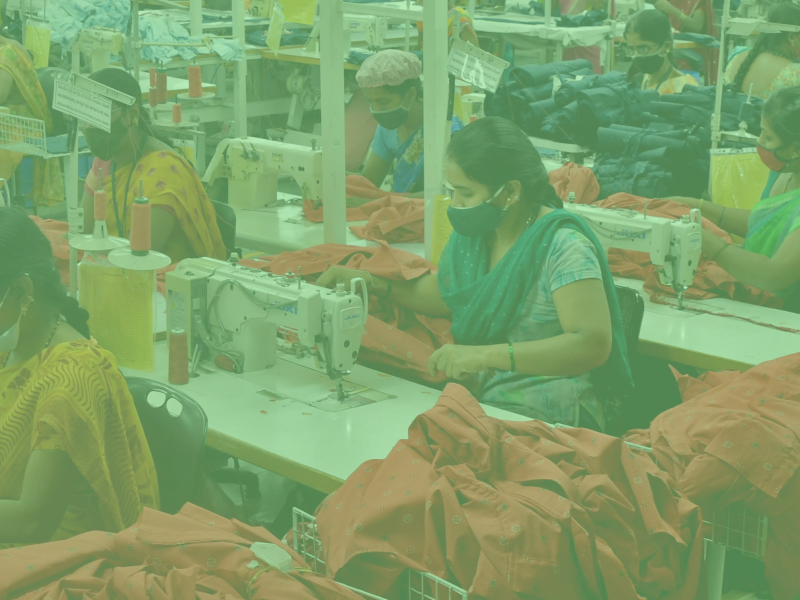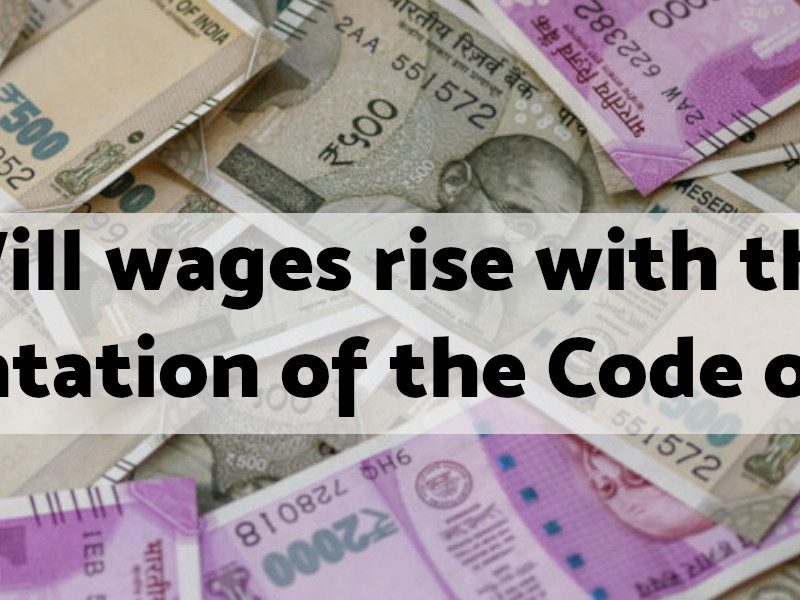How does plastic reach our food chain?
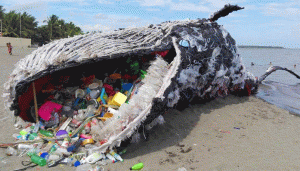
Do you remember a time when you had to carry a cloth or a jute bag to the market to buy groceries? Sugar and dal back then came in paper bags which could spill. You had to carry a glass bottle for buying cooking oil. The 1990s liberated us of many things, including this. We no longer had to carry our bags and bottles to shops. Instead shops gave us what we bought, wet or dry, in plastic bags and containers & life became simpler.
Single Use Plastic: Today plastic is all around us. Companies which produce plastic, love it. They have successfully sold us the idea that plastic is cheap, efficient and that packing, storing and carrying things would be impossible without it. World over more than 10 lakh plastic bags are used every minute.
Plastic packaging has helped the companies reach what they call ‘bottom of the pyramid’ customers. In the corporate marketing world, these are consumers who cannot afford to use a product at the existing price. For them, the companies tweak the quantity and quality of the product into small sachets thereby reducing the selling price to reach these customers. For instance, a 650 ml Clinic Plus shampoo costs Rs. 234.50. For a daily wage worker in rural India this is unaffordable when the minimum agricultural wage is on an average less than Rs. 150 per day. But, the company offers a sachet of the same at Re. 1 for 6 ml which makes it highly affordable. The company also pushes this package into remote villages through their marketing network, reaching the smallest pan shop on the street and into homes, via advertising on television. It sells a dream along with its product – a dream of a better world – a dream that allows every person irrespective of their economic condition, their caste, their religion, their education transcend to a better world through the use of this product.
Companies often also have a vested interest in selling articles in smaller packets. Let us take the example of a sachet of tomato ketchup. A bottle of 950 g costs Rs. 89 off the shelf, while a sachet of 8 g costs only Rs. 2 making it easily affordable. The per unit cost of ketchup in the bottle is 9 paise while in the sachet, it is 25 paise! So it is more profitable to sell ketchup in sachets than in a reusable glass bottle. So the poor unknowingly pay more to buy this product than the rich do. And if we multiply this with the number of buyers in each category, it makes more business sense to focus on the poor than the rich. And this business strategy is reliant on single-use plastic packaging. It cannot be reused either by the consumers or the company and finds its way into garbage dumps, into rivers, into our soil. This is consumed by animals, fish and reaches our food chain.
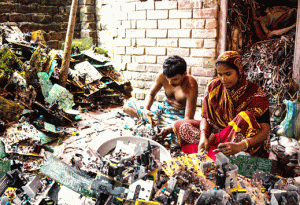 Tech Devices: It is official: there are now over 1.26 billion more mobile connections than people worldwide. With mobile phones and connections becoming cheaper, it is no longer a luxury good. Then there are ear phones, television, laptops, refrigerators, washing machines, microwave ovens, solar panels – every one of these has plastic in it. Globally, 44.7 million metric tonnes of e-waste was produced in 2016, equal in weight to 4500 Eiffel towers!
Tech Devices: It is official: there are now over 1.26 billion more mobile connections than people worldwide. With mobile phones and connections becoming cheaper, it is no longer a luxury good. Then there are ear phones, television, laptops, refrigerators, washing machines, microwave ovens, solar panels – every one of these has plastic in it. Globally, 44.7 million metric tonnes of e-waste was produced in 2016, equal in weight to 4500 Eiffel towers!
Reaching the landfill however is the last phase in the life cycle of a plastic product. The production of the plastic is equally draining on the environment. It requires a lot of water to produce plastic and the production process often leaves residue which pollutes the environment.
Take for example the mobile phone – it consists of 40% metals, 40% plastics, and 20% ceramics and trace materials. The circuit boards are made from mined materials containing copper, gold, lead, nickel, zinc and other metals. The manufacturing process requires crude oil for plastic, and sand and limestone for fiberglass. Many of these materials are known as “persistent toxins” and can stay in the environment for long periods of time. Other major components are battery, power banks and portable chargers. These batteries contain nickel, cobalt, zinc, cadmium, and copper. These are all mined from the earth and very toxic for the people who mine these and dispose these as well as for the planet, once disposed. Larger the device, more plastic and metals are used in manufacturing it.
It is not just the material that is used to produce it, that has an adverse impact on our environment. The machines that are used for manufacturing these devices, the manufacturing and the business processes have an equally harmful impact.
‘Creative Destruction’: Two investigations, one in France and one in the UK, found that Amazon destroys its unsold items. In June, France announced a crackdown on the destruction of unsold or returned consumer products. This ban will come into effect in the next four years. According to government estimates, over 650 million euros worth of new consumer products are thrown away or destroyed in France every year. British fashion brand, Burberry last year admitted that it burns unsold clothes, accessories and perfume worth over 31 million euros annually to retain their exclusivity. They are not an exception in the industry.
To retain or gain an edge over their competition in the market, companies incessantly engage in product and process innovation through which they create ‘new’ products. These ‘new’ products replace the earlier ones. The older ones are then taken off the shelves and destroyed to ensure new products are bought.
We see this always with mobile phones. The old Nokia phone that allowed us to make and receive calls and send messages is no longer available in the market. We are forced to buy fancy touch phones, which many of us even find difficult to use. Further, these are more expensive and have less use life. So we are pushed into buying these and the older versions of the phones are destroyed so that we cannot buy those. Management books call this ‘creative destruction’. This process is also not a one-time cycle, it is a continuous cycle that keeps repeating itself. As one company innovates and creates a ‘new’ product, profits for the company soar as all consumers rush to buy the ‘new’ product. But competing companies eventually ‘catch up’ on the innovation and the product no longer remains ‘new’ and profits shrink. And once again a ‘new’ product has to be launched to push the profit margin higher. What is also critical in this cycle is: (i) short use life of the ‘new’ products, and (ii) destruction of the old product which ensures that people are forced to buy the ‘new’ product.
This constant push for producing ‘new’ products means companies need access to an unhindered supply of minerals and precious metals on the cheap. This takes companies into mineral rich low- and middle- income countries in Africa and Asia to source these minerals. The mining industry is notorious for violating workers’ rights, promoting child labour and being ruthless with the environment and communities living in these mining areas.
Even when the supply of minerals ensured, companies do not stop. They innovate their production process to improve their competitive edge further. Robots and machines replace humans, which again have their own shelf life and in few years find their way to a waste dump.
The exploitation resources of countries in the global south continues through the life cycle of the products. Once these ‘new’ products are bought and discarded in the global north, these discarded products are shipped back to the countries in the global south to be disposed off. The understanding in the global north is that by sending away their waste, their environment and people remain protected from the harmful effects of this waste. It is possibly partially true as far as the direct impacts are concerned but pollution unfortunately cannot be restricted by political boundaries. Germany and France recorded temperatures as high as 38 – 45 degree Celsius this June. Global warming is a reality, not a perception of a few and it affects the poor more, both in the global north and in the global south.
The severe water crisis in Chennai in the last two months led to violent clashes in the city, offices have had to be shut down and has left people more dependent on private water vendors. 1 truck of water supplied by the Municipal body is priced at Rs.1000 but access to it is severely rationed, while private vendors are selling the same for Rs. 3000 – 6000. This makes it beyond the reach of the working poor of the city.
Is Ethical Consumption a solution?
Ethical consumption is often mooted as an alternative to consumerism sustained by exploitation of people and natural resources. This is rooted in arousing the sense of morality of the consumer by taking producers’ and workers’ rights along the supply chain into consideration, not harming animals in the process and keeping the environment protected. And all this of course comes at a premium. An ethically produced egg by a company in Tamil Nadu costs Rs. 25 a piece while a standard egg costs Rs. 4-6 in our country! The argument put out is often that the 25 rupee-egg does not hurt the animal, the farmer and the environment. It may be true but what about the ‘bottom of the pyramid’ consumer who could in 25 rupees buy 5 eggs and feed her entire family a meal of egg curry? Can we opt for a solution where she must stop feeding eggs to her children because she cannot afford the Rs. 25 egg? This would imply that only those who can afford the Rs. 25 egg deserve the nutrition that it provides.
Ethical consumption is yet another method of making money for companies. This marketing strategy is one that reaches out to that section of elite consumers who feel guilty of their privilege. These companies through their billion dollar media campaigns establish the narrative of ‘ethical consumption’. Ethical consumers switch to an air conditioner or refrigerator that consumes less electricity. However, they still buy this ‘new feel-good’ AC. Similarly for clothes and food and any other product. The consumption does not change, the product changes. This form of consumerism does very little to save the environment – it shifts consumption from one kind of products to a different kind of products.
This creates a division in the world between the rich who can afford to be ethical and the poor who are forced to buy products of everyday use in plastic packaging. It portrays the bottom of the pyramid consumers as criminals destroying the planet by using shampoo sachets while it absolves the corporates who push this ‘use and throw’ strategy that multiplies their profits and destroys the planet.
In 2014, CocaCola had to shut down one of its units at Varanasi, over protests that the bottling plant was extracting too much groundwater that breached the conditions of the license. The plant was also releasing effluents that contained pollutants beyond the permissible limit. People living in the area held protests, filed complaints and finally the Pollution Control Board ordered CocaCola to shut down and take suitable measures to recharge the depleting groundwater level by twice the amount they have already extracted. This is one small example – there are many across the world and in our country where people have come together and held corporations responsible for the damages they cause not just to people but to the environment. Many struggles have been won and many more have been lost in the face of the power of corporations.
Change is possible only through collective action. The fight against climate change and our collective access to natural resources cannot be through individual consumer actions that make some people feel good.

